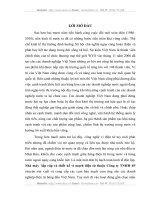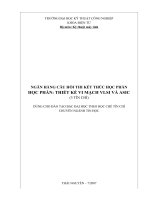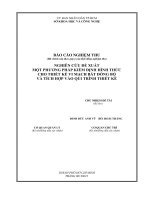Slide thiết kế vi mạch chapter5 behavioralmodel part2
Bạn đang xem bản rút gọn của tài liệu. Xem và tải ngay bản đầy đủ của tài liệu tại đây (1.33 MB, 43 trang )
Digital Design with the Verilog HDL
Chapter 5: Behavioral Model - part 2
Dr. Phạm Quốc Cường
Use some Prof. Mike Schulte’s slides ()
Computer Engineering – CSE – HCMUT
CuuDuongThanCong.com
/>
1
Interacting Behaviors [1]
• Assignments can trigger other assignments
• Nonblocking assignments CAN trigger blocking assignments
always @ (posedge clk)
begin
…
A <= B;
…
end
always @ (A, C)
begin
…
D = A & C;
…
end
• In hardware, reflects that the output of the A flip flop or
register can be the input to combinational logic
• When the FF changes value, that change must propagate
through the combinational logic it feeds into
2
CuuDuongThanCong.com
/>
Interacting Behaviors [2]
always @ (posedge clk or posedge rst) // behavior1
if (rst) y1 = 0; //reset
else y1 = y2;
always @ (posedge clk or posedge rst) // behavior2
if (rst) y2 = 1; // preset
example taken from
else y2 = y1;
Cummings paper!
• If behavior1 always first after reset, y1 = y2 = 1
• If behavior2 always first after reset, y2 = y1 = 0.
• Results are order dependent, ambiguous – race condition!
• This is why we don’t use blocking assigns for flip-flops…
3
CuuDuongThanCong.com
/>
Interacting Behaviors [3]
always @ (posedge clk or posedge rst)
if (rst) y1 <= 0; //reset
else y1 <= y2;
always @ (posedge clk or posedge rst)
if (rst) y2 <= 1; // preset
else y2 <= y1;
•
•
•
•
example taken from
Cummings paper!
Assignments for y1 and y2 occur in parallel
y1 = 1 and y2 = 0 after reset
Values swap each clock cycle after the reset
No race condition!
4
CuuDuongThanCong.com
/>
Synchronous/Asynchronous Reset
• Synchronous: triggered by clock signal
module dff_sync(output reg Q, input D, clk, rst);
always @(posedge clk) begin
if (rst) Q <= 1’b0;
else Q <= D;
end
endmodule
• Asynchronous: also triggered by reset signal
module dff_async(output reg Q, input D, clk, rst, en);
always @(posedge clk, posedge rst) begin
if (rst) Q <= 1’b0;
else if (en) Q <= D;
end
endmodule
CuuDuongThanCong.com
/>
5
What Happens Here?
module dff_BAD(reg output Q, input D, clk, rst);
always @(posedge clk, reset) begin
if (rst) Q <= 1’b0;
else Q <= D;
end
endmodule
Does this give incorrect behavior?
6
CuuDuongThanCong.com
/>
Datatype Categories
• Net
–
–
–
–
Represents a physical wire
Describes structural connectivity
Assigned to in continuous assignment statements
Outputs of primitives and instantiated sub-modules
• Variables
– Used in Behavioral procedural blocks
– Can represent:
• Synchronous registers
• Combinational logic
7
CuuDuongThanCong.com
/>
Variable Datatypes
•
•
•
•
•
reg – scalar or vector binary values
Not necessarily a
integer – 32 or more bits
“register”!!!
time – time values represented in 64 bits (unsigned)
real – double real values in 64 or more bits
realtime - stores time as double real (64-bit +)
• Assigned value only within a behavioral block
• CANNOT USE AS:
– Output of primitive gate or instantiated submodule
– LHS of continuous assignment
– Input or inout port within a module
• real and realtime initialize to 0.0, others to x…
– Just initialize yourself!
8
CuuDuongThanCong.com
/>
Examples Of Variables
reg signed
[7:0] A_reg;
// 8-bit signed vector register
reg
Reg_Array[7:0];
// array of eight 1-bit registers
integer
Int_Array[1:100];
// array of 100 integers
real
B, Real_Array[0:5]; // scalar & array of 6 reals
time
Time_Array[1:100];
// array of 100 times
realtime D, Real_Time[1:5]; // scalar & array of 5 realtimes
initial
begin
A_reg = 8’ha6;
// Assigns all eight bits
Reg_Array[7] = 1;
// Assigns one bit
Int_Array[3] = -1;
// Assign integer -1
B = 1.23e-4;
// Assign real
Time_Array[20] = $time;
// Assigned by system call
D = 1.25;
// Assign real time
end
9
CuuDuongThanCong.com
/>
wire vs. reg
• Same “value” used both as ‘wire’ and as ‘reg’
module dff (q, d, clk);
output reg q;
// reg declaration,
input wire d, clk;
// wire declarations, since module inputs
always @(posedge clk) q <= d; // why is q reg and d wire?
endmodule
module t_dff;
wire q, clk;
reg d;
dff FF(q, d, clk);
clockgen myclk(clk);
initial begin
d = 0;
#5 d = 1;
end
endmodule
// now declared as wire
// now declared as reg
// why is d reg and q wire?
10
CuuDuongThanCong.com
/>
Signed vs. Unsigned
• Net types and reg variables unsigned by default
– Have to declare them as signed if desired!
reg signed [7:0] signedreg;
wire signed [3:0] signedwire;
• All bit-selects and part-selects are unsigned
– A[6], B[5:2], etc.
• integer, real, realtime are signed
• System calls can force values to be signed or unsigned
reg [5:0] A = $unsigned(-4);
reg signed [5:0] B = $signed(4’b1101);
11
CuuDuongThanCong.com
/>
Operators with Real Operands
• Arithmetic
– Unary +/– + - * / **
• Relational
– > >= < <=
• Logical
– ! && ||
• Equality
– == !=
No others allowed!
No bit-selects!
No part-selects!
• Conditional
– ?:
12
CuuDuongThanCong.com
/>
Strings
• Strings are stored using properly sized registers
reg [12*8: 1] stringvar;
stringvar = “Hello World”;
•
•
•
•
// 12 character string
// string assignment
Uses ASCII values
Unused characters are filled with zeros
Strings can be copied, compared, concatenated
Most common use of strings is in testbenches
13
CuuDuongThanCong.com
/>
Memories
• A memory is an array of n-bit registers
reg [15:0] mem_name [0:127];
//128 16-bit words
reg array_2D [15:0] [0:127]; // 2D array of 1-bit regs
• Can only access full word of memory
mem_name[122] = 35;
mem_name[13][5] = 1;
array_2D[122] = 35;
array_2D[13][5] = 1;
// assigns word
// illegal – works in simulation
// illegal – causes compiler error
// assigns bit
• Can use continuous assign to read bits
assign mem_val = mem[13];
// get word in slot 13
assign out = mem_val[5]; // get bit in slot 5 of word
assign dataout = mem[addr];
assign databit = dataout[bitpos];
14
CuuDuongThanCong.com
/>
Example: Memory
module memory(output reg [7:0] out, input [7:0] in, input [7:0] addr,
input wr, clk, rst);
reg [7:0] mem [0:255];
reg [8:0] initaddr;
always @ (posedge clk) begin
if (rst) begin
for (initaddr = 0; initaddr < 256; initaddr = initaddr + 1) begin
mem[initaddr] <= 8’d0;
end
end else if (wr) mem[addr] <= in;
end
always @(posedge clk) out <= mem[addr];
endmodule
15
CuuDuongThanCong.com
/>
Example: Memory
module memory(output reg [7:0] out, input [7:0] in, input [7:0] addr,
input wr, clk, rst);
reg [7:0] mem [0:255];
reg [8:0] initaddr;
always @ (posedge clk) begin
if (rst) begin
synchronous
reset!+ 1) begin
for (initaddr = 0; initaddr < 256; initaddr
= initaddr
mem[initaddr] <= 8’d0;
end
synchronous write
end else if (wr) mem[addr] <= in;
end
always @(posedge clk) out <= mem[addr];
synchronous read
endmodule
16
CuuDuongThanCong.com
/>
Control Statements
• Behavioral Verilog looks a lot like software
– (risk! – danger and opportunity)
• Provides similar control structures
– Not all of these actually synthesize, but some nonsynthesizable statements are useful in testbenches
• What kinds synthesize?
– if
– case
– for loops with constant bounds
17
CuuDuongThanCong.com
/>
if… else if… else
• Operator ? : for simple conditional assignments
• Sometimes need more complex behavior
• Can use if statement!
– Does not conditionally “execute” block of “code”
– Does not conditionally create hardware!
– It makes a multiplexer or similar logic
• Generally:
– Hardware for all paths is created
– All paths produce their results in parallel
– One path’s result is selected depending on the condition
18
CuuDuongThanCong.com
/>
Potential Issues With if
• Can sometimes create long multiplexer chains
always @(select, a, b, c, d) begin
out = d;
if (select == 2’b00) out = a;
if (select == 2’b01) out = b;
if (select == 2’b10) out = c;
end
always @(a, b, c, d) begin
if (a) begin
if (b) begin
if (c) out = d;
else out = ~d;
else out = 1;
else out = 0;
end
19
CuuDuongThanCong.com
/>
if Statement: Flip-Flop Set/Reset
module df_sr_behav (q, q_n, data, set, reset, clk);
input
data, set, clk, reset;
output q, q_n;
reg
q;
assign q_n = ~q;
// continuous assignment
always @ (posedge clk) begin // Flip-flop with synchronous set/reset
if (reset) q <= 1’b0;
// Active-high set and reset
else if (set) q <= 1’b1;
else q <= data;
end
endmodule
• Does set or reset have priority?
20
CuuDuongThanCong.com
/>
case Statements
• Verilog has three types of case statements:
– case, casex, and casez
• Performs bitwise match of expression and case item
– Both must have same bitwidth to match!
• case
– Can detect x and z! (only in simulation)
• casez
– Can detect x (In simulation)
– Uses z and ? as wildcard bits in case items and expression
• casex
– Uses x, z, and ? as wildcard bits in case items and expression
21
CuuDuongThanCong.com
/>
Using case To Detect x And z
• Only use this functionality in a testbench; it won’t
synthesize!
• Example taken from Verilog-2001 standard;
• Cannot be synthesized
case (sig)
1’bz:
$display(“Signal is floating.”);
1’bx:
$display(“Signal is unknown.”);
default:
$display(“Signal is %b.”, sig);
endcase
22
CuuDuongThanCong.com
/>
casex Statement
• Uses x, z, and ? as single-bit wildcards in case item and expression
• Uses only the first match encountered – Inherent priority!
• Treats x, z, and ? as don’t care
always @ (code) begin
casex (code)
// case expression
2’b0?: control = 8’b00100110; // case item1
2’b10: control = 8’b11000010; // case item 2
2’b11: control = 8’b00111101; // case item 3
endcase
end
What is the output for code = 2’b01?
What is the output for code = 2’b1x?
casex construct is often used to describe logic with priority
23
CuuDuongThanCong.com
/>
casez Statement
• Uses z, and ? as single-bit wildcards in case item and expression
• Use z as don’t care, x is a value
says we don’t care what
control is in other cases… more
• Uses first match encountered
on this next…
always @ (code) begin
casez (code)
2’b0?: control = 8’b00100110; // item 1
2’bz1: control = 8’b11000010; // item 2
default: control = 8b’xxxxxxxx; // item 3 endcase
end
Adding a default case
What is the output for code = 2b’01?
statement is a great way to
avoid inferring latches and
What is the output for code = 2b’zz?
make debugging easier!
24
CuuDuongThanCong.com
/>
“Don’t Care” Assignment With case
• Sometimes we know not all cases will occur
• Can “don’t care” what is assigned
always@(state, b) begin
case (state)
// state is “expression”
2’d0: next_state = 2’d1;
// 2’d0 is case item
2’d1: next_state = 2’d2;
// ordering implied
2’d2: if (b) next_state = 2’d0;
else next_state = 2’d1;
default: next_state = 2’dx; // for all other states,
endcase
// don’t care what is
end
// assigned
25
CuuDuongThanCong.com
/>









